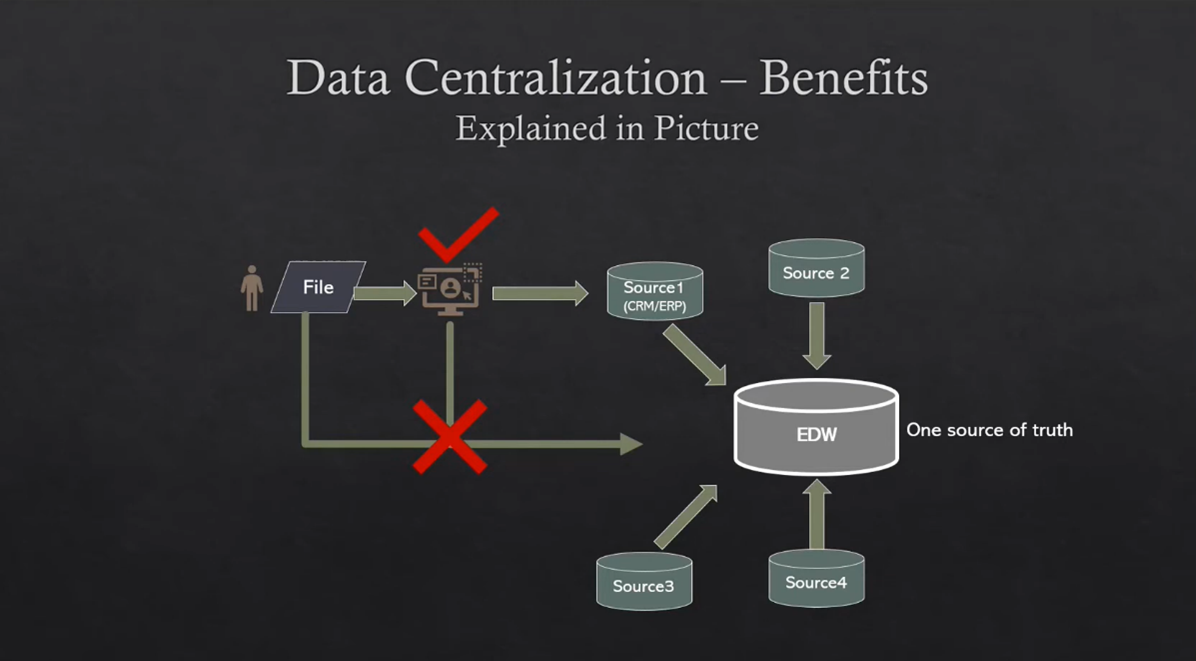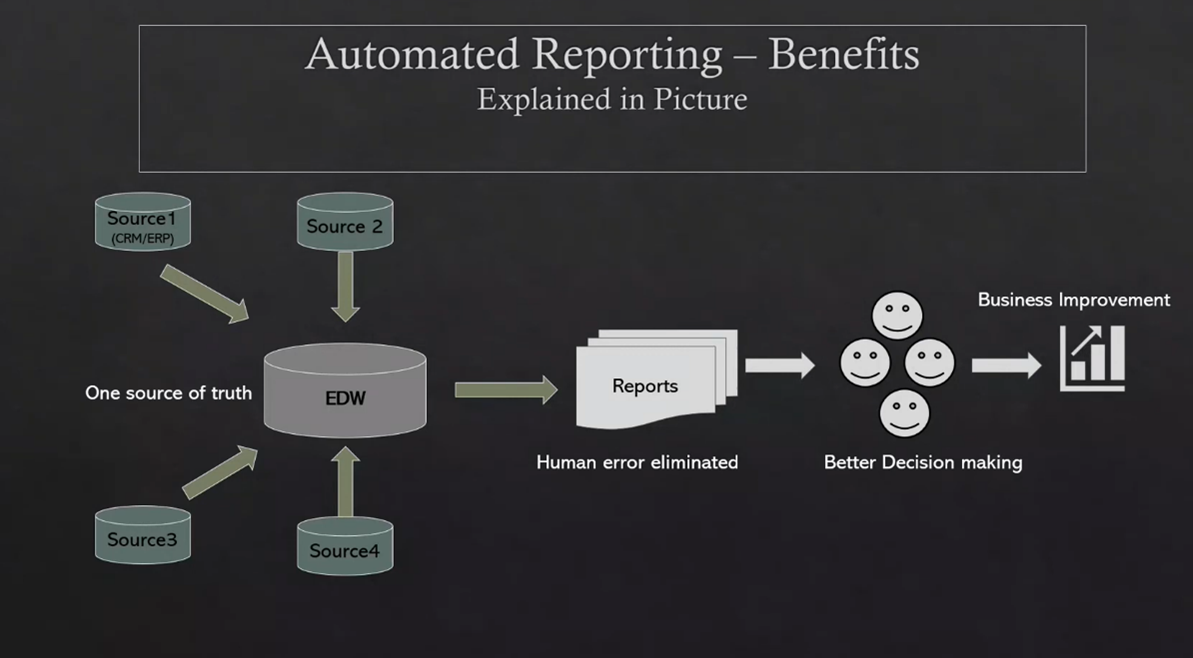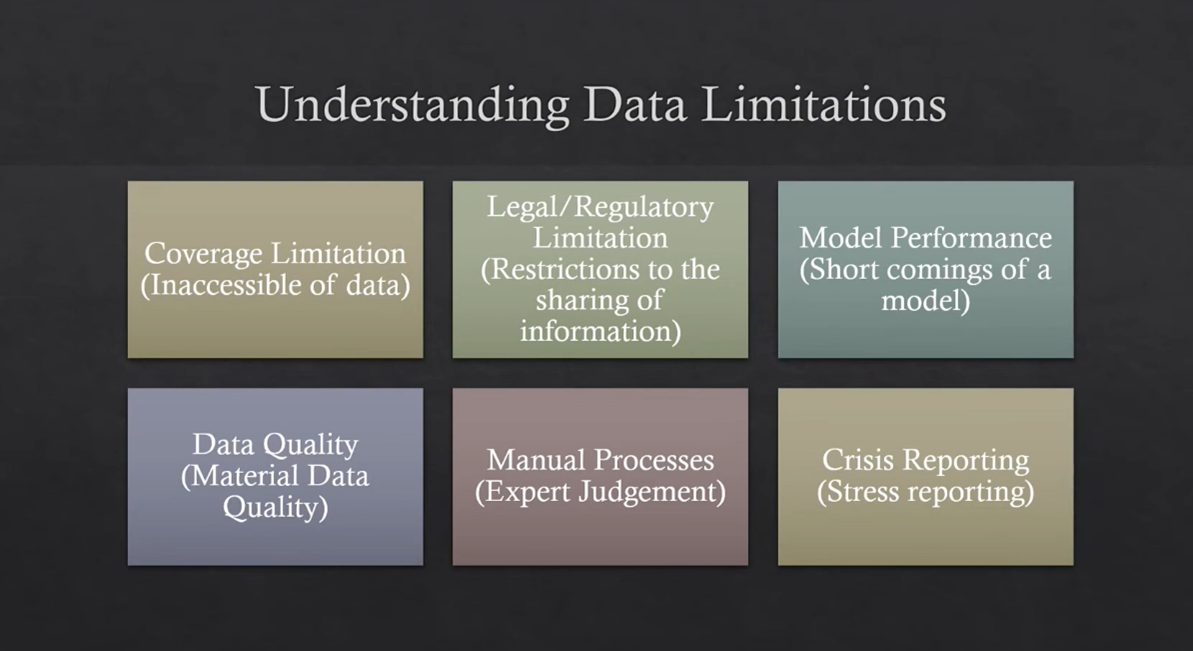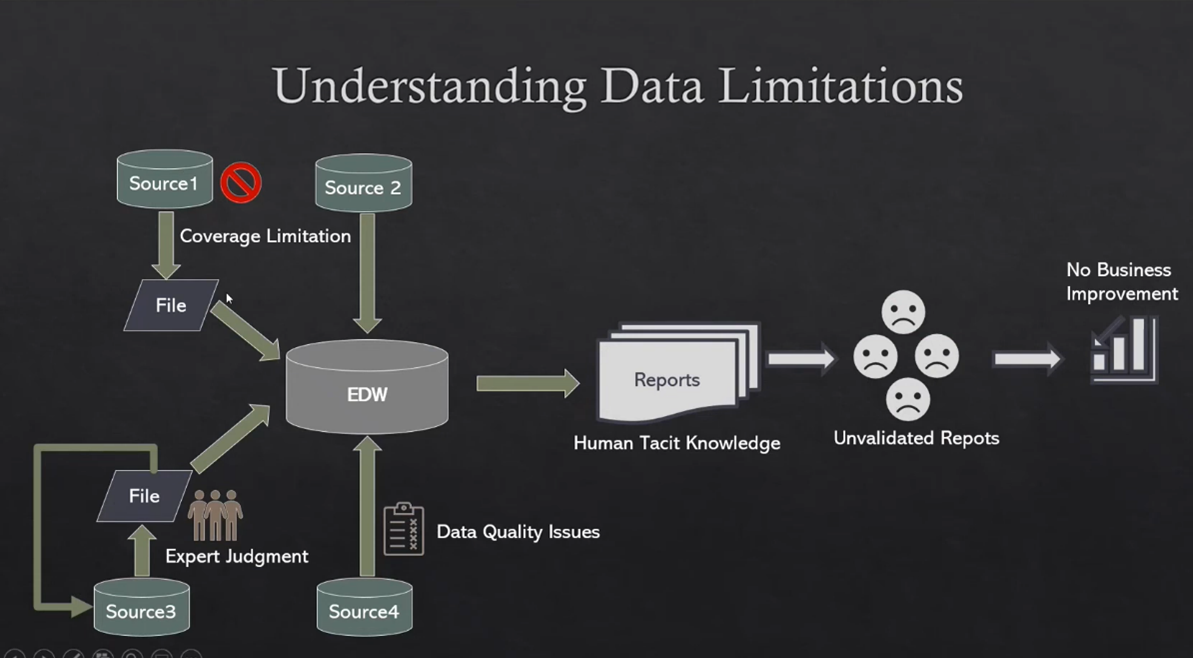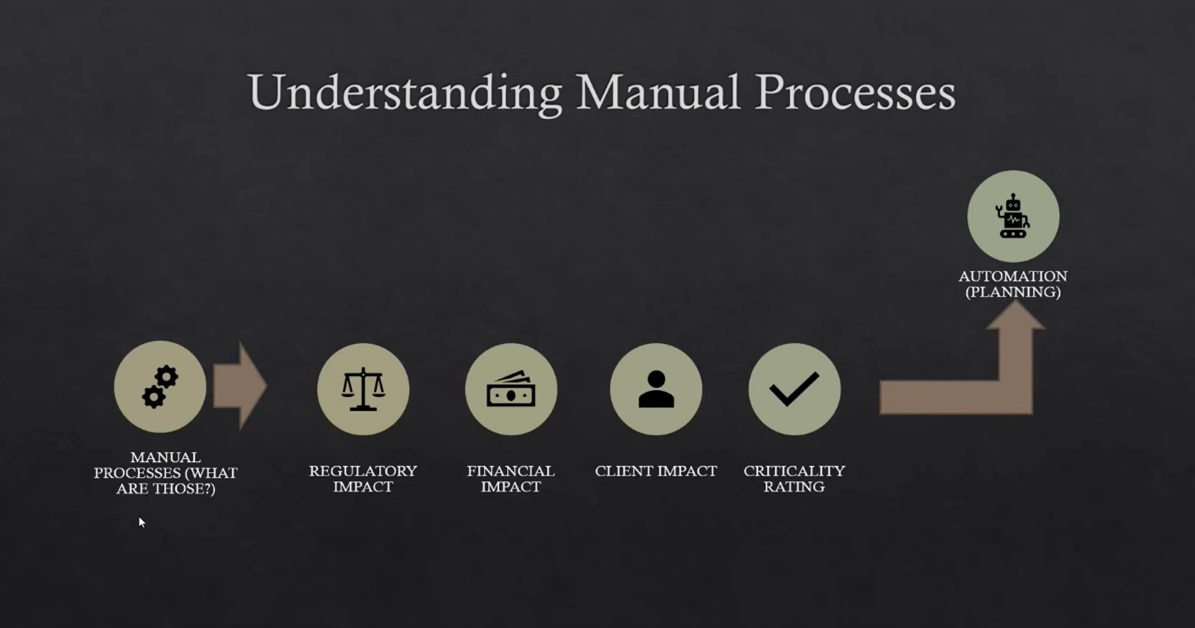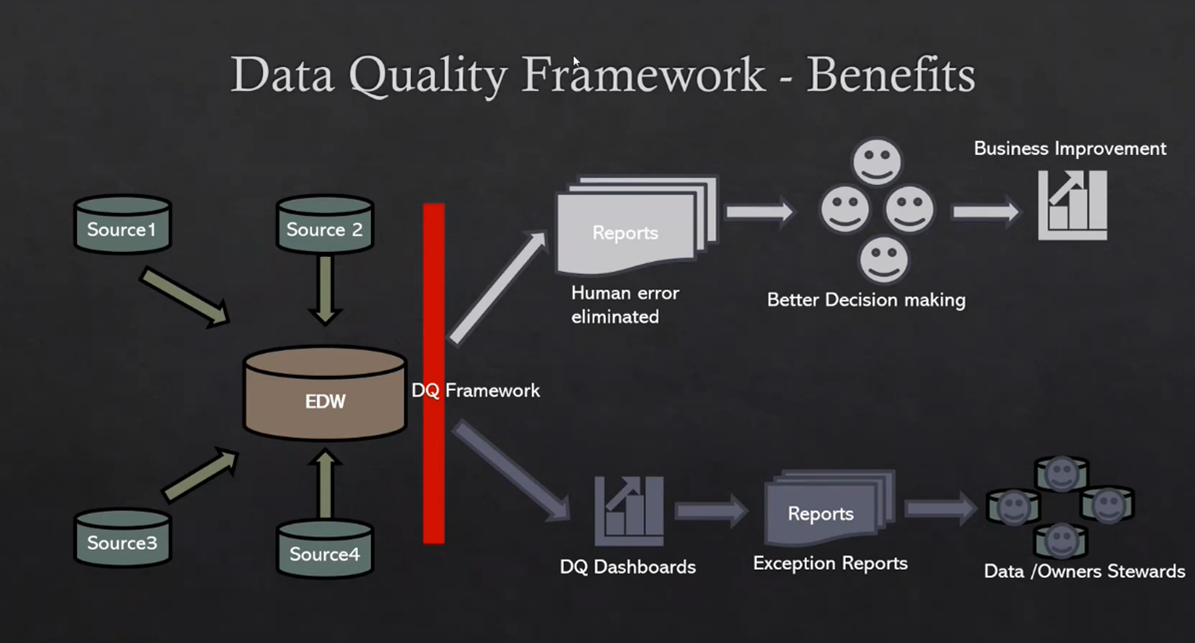The Benefits to Data Centralisation and Automated Reporting with Faith Sithole
Executive Summary
Data centralisation and report automation have become essential for effective data management. Centralised data management is crucial for businesses as it provides several benefits, such as improved data accuracy, better security, and easier access. Faith Sithole discusses the importance of an efficient interface for data storage cannot be overstated, as it plays a key role in ensuring data centralisation. She notes that report automation is equally important as it helps businesses save time and resources while improving the accuracy and consistency of reports. Implementing a data warehouse also has several benefits, such as improved data quality, better data analysis, and streamlined reporting. At the same time, data centralisation has many advantages but is not the same as data virtualisation. Implementing data systems has limitations and challenges, including data reporting and analysis, data flexibility, and data lineage. Manual processes can also impact data quality and reporting accuracy. Lastly, a data validation and reporting control framework is emphasised to ensure data quality and accuracy.
Webinar Details
Title: The Benefits of Data Centralisation and Automated Reporting
Date: 15 December 2021
Presenter: Faith Sithole
Meetup Group: Big Data & Data Science
Write-up Author: Howard Diesel
Contents
Data Centralization and Report Automation
Benefits of Data Centralization
Data Centralization Benefits
Importance of Centralized Data Management
Benefits of Data Centralization and Importance of Interface in Data Storage
Report Automation Benefits
Benefits of Implementing a Data Warehouse
Data Centralization vs. Data Virtualization
Benefits of Centralization and Automation in Data Management
Limitations and Challenges of Implementing Data Systems
Limitations in Data Reporting and Analysis
Limitations in Reporting and Data Flexibility
Limitations of Data Lineage and Manual Processes in Reporting
Manual Processes and Their Impacts
Importance of a Control Framework in Data Validation and Reporting
Data Quality and Dashboarding
Data Quality and Validation
Data Quality and Control Frameworks
Implementing Data Quality in Data Analysis
Data Centralization and Report Automation
Faith Sithole introduces data centralisation and report automation as separate components. Data centralisation involves various processes that must be completed before the data can be centralised. Similarly, report automation requires specific processes before automating the data through a chosen report. The audience was asked to consider a scenario of being in a supermarket and needing to stock up on bakery products for family, friends, or themselves.
Benefits of Data Centralization
Centralised data offers several benefits, including convenience and efficiency when navigating a store or business. It can streamline the process of finding specific products and reduce the need for extensive searching or assistance from staff. For example, locating all baking-related products in one aisle can make it easier for individuals to find everything they need. These benefits will be discussed further, focusing on advantages rather than technical aspects. The discussion will cover data centralisation, report transformation, and its benefits. A deeper understanding of the benefits can generate interest in implementing and understanding the technical implementation process while acknowledging the limitations of data and the need for automation in processes alongside the desire for centralisation.
Data Centralization Benefits
Data centralisation is a crucial aspect that enhances the infrastructure for reporting by providing a clear understanding of how data flows between systems for reporting purposes. This centralised approach improves decision-making across the business, allowing easy access to all necessary information enabling quicker and more informed decision-making. In addition, having centralised data means that information is readily accessible, reducing the need to ask questions or seek additional data from subject matter experts and experts, ultimately leading to better decision-making.
Figure 1 Data Centralization – Benefits
Figure 2 Data Centralization - Benefits, Explained in Picture
Importance of Centralized Data Management
Centralised data management is critical for businesses as it can help improve decision-making, reduce financial losses, and enhance overall information management. By having all the data in one place, companies can better understand their customers before lending or providing services, gain insights for better decision-making, and improve the speed of accessing information. With centralised data management, businesses can improve their strategy planning and prioritisation quality while identifying areas for automation and future planning by understanding limitations and manual processes.
Benefits of Data Centralization and Importance of Interface in Data Storage
Data centralisation is a crucial process that allows businesses to keep track of data sources, create smaller projects, and streamline manual processes. With an interface to enter data into the central storage system, companies can automate data entry and improve data management and analysis. While loading data from files may not be reliable, using an interface ensures easy data analysis and understanding of when and how data was captured. Centralisation can be achieved through different systems such as enterprise data warehouses, big data systems, or other systems like EWS.
Report Automation Benefits
Automated report generation is a streamlined process that saves time and eliminates potential errors associated with manual data collection. To develop automated reports, it is essential to understand data flow and other processes in place. Once developed, automated reports can be used repeatedly with the click of a button and provide a multi-perspective view of data, allowing for different analyses and storytelling. Various ideas of data can be generated based on specific needs and reporting requirements.
Figure 3 Report Automation – Benefits
Figure 4 Report Automation – Benefits, Explained in Picture
Benefits of Implementing a Data Warehouse
A data warehouse implementation ensures the availability of accurate and up-to-date information. Business and data analysts gather requirements and obtain the right data, while ETLs and control frameworks ensure data quality and accuracy. Using a system reduces human error and provides continuity even with staff turnover, allowing for easy viewing and manipulation of data. By eliminating dependencies on multiple sources for data retrieval, a data warehouse provides value when the benefits outweigh the costs.
Data Centralization vs. Data Virtualization
Data centralisation and data virtualisation are two different approaches to managing and accessing data. Data centralisation involves moving all data to a central location, such as a data warehouse. In contrast, data virtualisation involves creating a virtual layer that accesses data from different sources without physically moving it. The choice between centralisation and virtualisation depends on factors such as the complexity of the business, the number of systems, and the need for data quality control. While consolidating everything into a data warehouse may not always be worthwhile, data virtualisation can be a good alternative, allowing for data extraction and presentation through a virtual layer while leveraging existing data quality and source systems.
Benefits of Centralization and Automation in Data Management
Centralising and automating data management processes can provide numerous benefits. By centralising data, data quality checks can run on multiple systems and ensure consistency while reducing human error. Reports requirements and analysis can be addressed before data reaches the centralised system, and any changes or additions to the data must go through a process of change logic. Once centralised, reports can be generated easily and consistently once centralised, and stakeholders, including users and executives, benefit from accurate and well-analyzed data. This helps to enhance the ability to make better decisions and provide a comprehensive view of data, such as sales by region.
Limitations and Challenges of Implementing Data Systems
Visual graphs and data systems can enhance decision-making and streamline processes, leading to increased sales. However, it is important to consider the limitations and challenges of implementing such systems. For instance, data accessibility may be restricted if systems lack end-to-end data lineage, and implementing system changes or improvements may require additional investment. Additionally, specific laws and regulations may limit access to customer information, necessitating data masking techniques.
Figure 5 Understanding Data Limitations
Limitations in Data Reporting and Analysis
Comprehensive data reporting and analysis limitations can arise from legal or regulatory restrictions, moral performance, data quality, and manual processes. Incomplete or inaccurate data can hinder effective decision-making and targeted marketing efforts. At the same time, expert judgment may be required to interpret and validate data, especially when automated models are not functioning optimally. This acknowledges the existence of relevant regulations' impact on data availability and the need for caution when relying on algorithms and formulas for data reporting and analysis.
Limitations in Reporting and Data Flexibility
Faith highlights the limitations associated with data sourcing from different systems or models and the challenges posed by legacy systems or black boxes that restrict access to underlying data. The experience of long-term employees can influence decision-making, but it may not always be transferable to a system. Furthermore, building urgent reports that meet regulatory requirements can have limitations and may require re-implementation. It is important to document these limitations and recognise their impact. Doing so can help in planning better and lead to initiatives to improve reporting and overall operations. The coverage limitation is compared to a "no entry" sign, indicating that there may be boundaries or restrictions in accessing certain systems or data.
Figure 6 Understanding Data Limitations
Limitations of Data Lineage and Manual Processes in Reporting
Relying on manual processes for data management can be time-consuming and limiting. It involves various methods, such as files or smaller data mods, which may not provide a comprehensive view of data lineage. Data quality issues can occur across systems, and relying on human knowledge can lead to data validation and reporting challenges. Unvalidated data can impact stakeholders, users, and executives, hindering business improvement and causing exhaustion during reporting periods. To overcome these challenges, it is essential to understand manual processes by identifying and comprehending the actual business process of reporting. This involves reviewing reported figures and values, identifying data sources, and reaching the golden source.
Figure 7 Understanding Manual Processes
Manual Processes and Their Impacts
When analysing manual processes, it is important to talk to different stakeholders to gather valuable information. Understanding manual processes can help identify necessary regulatory and financial impact assessments. The organisation's reputation can be negatively affected by misrepresenting client information or mishandling their products. To determine priorities for automation, it is important to assess the criticality of manual processes. Prioritisation of automation should be done only after thoroughly understanding manual processes. Visual representations like spreadsheets and SQL scripts can be useful in understanding manual processes. While SQL scripts may be used for data collection and reporting, they are not fully automated and sometimes require manual changes. Data may come into the system via files, and exporting the outcomes of SQL scripts to Excel can introduce potential errors or data adjustments.
Figure 8 Identifying Manual Processes
Importance of a Control Framework in Data Validation and Reporting
A control framework is crucial in ensuring accurate data validation and reporting, particularly in ETLs and data migration cases. Acting as a gateway, it filters and validates data before processing, ensuring that only good-quality data is pulled from various sources. The framework prevents data errors or missing information and enables the identification of any issues in the data, generating comprehensive reports that allow for quick fixes. Without such a framework, missing or filtered-out information would be difficult to identify, leading to reporting errors caused by human mistakes or failed transformation rules.
Figure 9 Control Framework - Benefits
Data Quality and Dashboarding
Having high-quality data is crucial for making informed business decisions. Inaccurate and incomplete data can lead to erroneous conclusions, which is why a Data Quality (DQ) framework is essential. The DQ framework includes setting thresholds or tolerance levels for incomplete data, allowing for concurrent reporting while simultaneously assessing the quality of data. Building a dashboard based on the DQ framework provides a comprehensive view of data quality, making it easier to identify areas that require improvement and ensure accurate reporting.
Figure 10 Data Quality Framework - Benefits
Data Quality and Validation
Data quality measures can be implemented manually or through a data quality (DQ) tool. The choice of approach depends on the company's maturity level and data management practices. By tracking their progress towards targets, businesses can improve data quality. DQ reports provide a comprehensive view of data quality maturity, while exception reports highlight specific records that fail certain dimensions. These reports can be automated and sent to designated data stewards and owners for data fixing. Although data fixing is a manual process, developing interfaces with validation rules can improve data quality by ensuring data is validated at entry. Lack of validation rules can result in poor data quality due to incorrect or unverified data being entered.
Data Quality and Control Frameworks
Ensuring clean and validated data is crucial to avoid data quality issues. Before capturing data, certain processes must be implemented to ensure its cleanliness and accuracy. The goal is an automated architecture accessible to everyone in the organisation. Proper documentation plays a key role in identifying issues during the migration, and control frameworks provide audit trails to track and monitor data quality. Implementation tools are used across frameworks like ETL, reporting, and data quality.
Implementing Data Quality in Data Analysis
Faith mentions various data quality tools, including QlikView, Power BI, IDQ, and ITT Cube, and acknowledges the importance of data quality (DQ) in data analysis. She recommends implementing DQ after data loading and providing feedback on exceptions to the source systems for fixing, while some suggested implementing DQ at different stages. The concept of a Data Vault was also brought up to quickly enter data into the warehouse and undergo DQ checks before being used in reports. Faith and others agreed on implementing data quality measurements at the capture point.
If you would like to join the discussion, please visit our community platform, the Data Professional Expedition.
Additionally, if you would like to be a guest speaker on a future webinar, kindly contact Debbie (social@modelwaresystems.com)
Don’t forget to join our exciting LinkedIn and Meetup data communities not to miss out!



